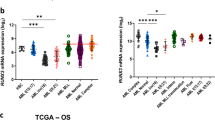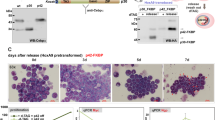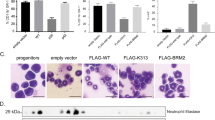Abstract
The EVI-1 gene encodes a Zn finger, DNA binding protein previously detected in some acute myelogenous leukemias (AML) and myelodysplasias (MDS), but not in normal marrow or cord blood cells. Experimental studies suggest EVI-1 blocks cellular differentiation by binding to GATA-1 or other specific DNA sequences controlling gene expression, and may be involved in the pathogenesis of some AMLs. To further define potential roles for EVI-1 in leukemia pathogenesis, we studied its regulation in acute promyelocytic leukemias (APL). Seven of 11 APL cases expressed EVI-1 RNA detected by RNA PCR at diagnosis, and expression was detected in two additional cases after treatment with all-trans retinoic acid (ATRA). Two of four cases studied at relapse also expressed EVI-1 RNA. To investigate regulation of EVI-1 expression in APL, we examined its expression in the NB4 APL cell line. NB4 cells did not express EVI-1 under basal conditions, but expressed EVI-1 after ATRA-induced differentiation. When NB4 cells were exposed to ATRA and transferred to cultures with N,N′-hexamethylene-bis-acetamide (HMBA), differentiation occurred but EVI-1 RNA was not detected, indicating that EVI-1 expression was not required for terminal, NB4 differentiation. ATRA-resistant NB4 cells were obtained by continuous culture in gradually increasing concentrations of ATRA. These cells did not express markers of differentiation but continued to express EVI-1 for several weeks even after ATRA withdrawal. To assess whether expression of the APL PML-RARα fusion gene alone was sufficient for ATRA induction of EVI-1, the PML-RARα gene cDNA was expressed in U937 histiocytic lymphoma cells. ATRA treatment of PML-RARα-transfected or control U937 cells did not induce EVI-1 expression. In conclusion, this study demonstrates the EVI-1 gene is consistently expressed in APL cells either constitutively or after ATRA treatment. ATRA represents the first biologically active agent shown to specifically regulate EVI-1 expression in blood cells. In contrast to previous studies in AML and MDS, the pattern of EVI-1 expression suggests it may facilitate rather than inhibit myeloid differentiation during ATRA treatment. However, effects of EVI-1 expression are likely to be complex, and expression in ATRA-resistant APL cells may indicate multiple roles for this gene.
This is a preview of subscription content, access via your institution
Access options
Subscribe to this journal
Receive 12 print issues and online access
$259.00 per year
only $21.58 per issue
Buy this article
- Purchase on Springer Link
- Instant access to full article PDF
Prices may be subject to local taxes which are calculated during checkout
Similar content being viewed by others
Author information
Authors and Affiliations
Rights and permissions
About this article
This article is cited by
-
Efficacy of All-Trans-Retinoic Acid in High-Risk Acute Myeloid Leukemia with Overexpression of EVI1
Oncology and Therapy (2019)
-
PML-RARA-associated cooperating mutations belong to a transcriptional network that is deregulated in myeloid leukemias
Leukemia (2017)
-
The human promyelocytic leukemia zinc finger gene is regulated by the Evi-1 oncoprotein and a novel guanine-rich site binding protein
Leukemia (2002)



